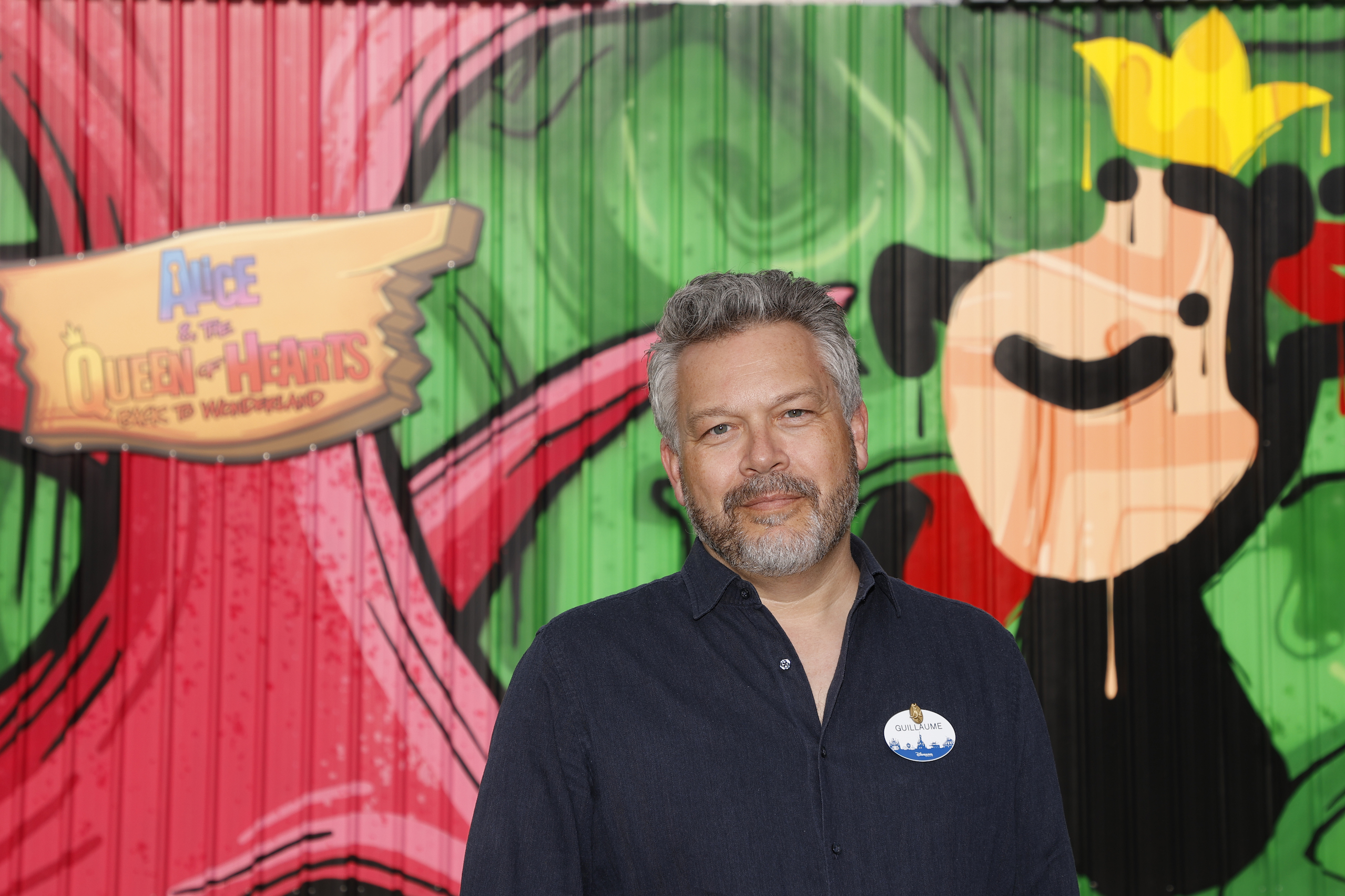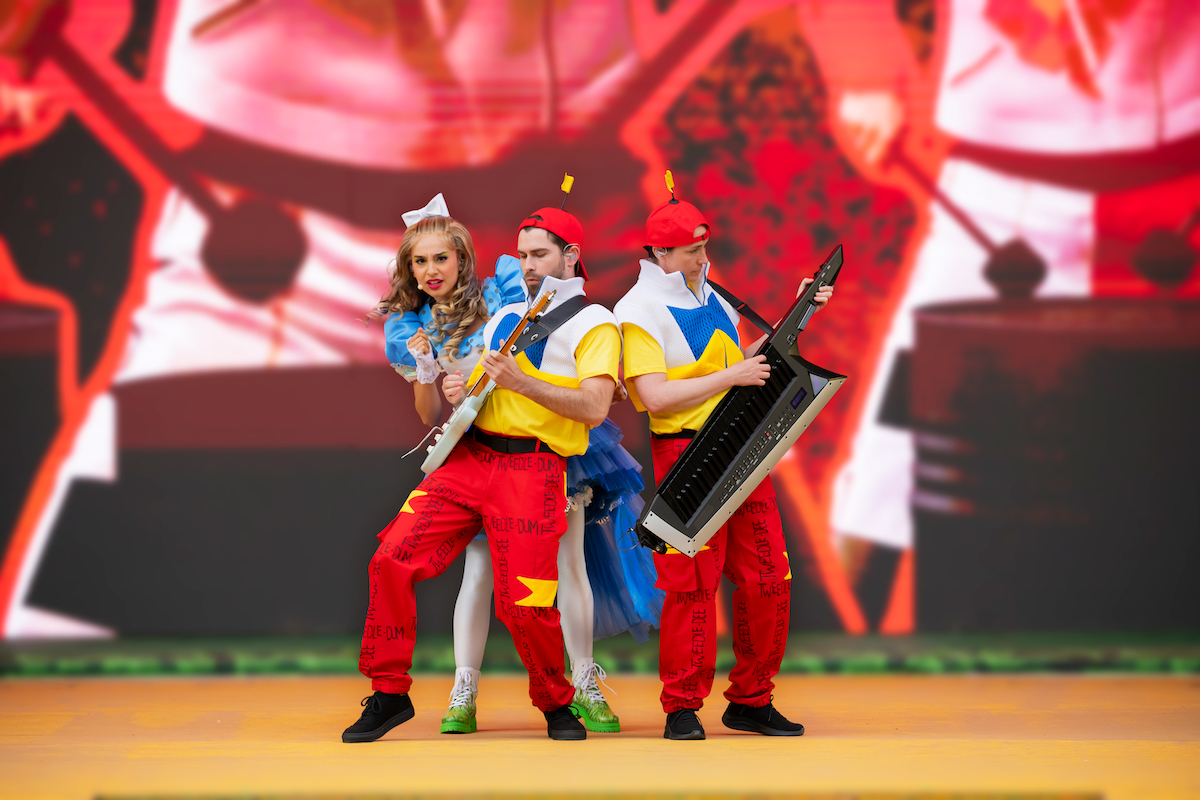This week, we invite you to find out more about the work of Guillaume Coignard, the Music Producer of the new musical Alice & the Queen of Hearts: Back to Wonderland, presented in the newly unveiled theater at Walt Disney Studios Park: “Theater of the Stars,” presented by EDF.

How did you create the show’s musical identity?
This is one of the most exciting and fun parts of the production journey since everything must be imagined. We based our work on the discussions we had with our show director, Matteo Borghi, one and a half years ago. He expressed his needs, and we drew our inspiration from different musical styles. We wanted to create something out of the ordinary, especially since this location – with its awe-inspiring décor – offers a very modern take on the beloved story of Alice in Wonderland.
We managed turned our ideas into reality by collaborating with our composer/arranger Chris Sernel, who is an extremely skilled artist. When you work with such talented artists, you always need to keep an open mind and make use of good ideas when they are suggested to you.
We are now looking forward to discovering your work! Can you tell us more about these songs?
Three musical worlds collide, and intertwine. First, the Mad Hatter start the show with a catchy pop song. Then, he is joined by other characters, including Alice, whose musical style is inspired by modern pop. She will transport us into her own little world and share her excitement and joy to be back in Wonderland after all these years. Soon after, the Queen of Hearts and her team arrive, bringing with her an array of rockin’ and electric vibes. Disappointed by the fact that she is not the only guest of honor, she go to a musical battle of the bands with Alice and her friends, and we will find out who the winner is at the end of the show.
How many songs will be performed?
We have written five original songs, along with a reorchestrated version for each of them. Therefore, eight songs are performed in total. It’s the first time we’ve include so many original songs in a show since I started working at Disneyland Paris!
What about instrumental songs?
Between each song, the story evolve like in a musical, with instrumental songs playing in the background. Inspired by the melodies from the original animated film, the underscores for the show were written by Tyler Koontz, an outstanding arranger who had already worked with us on other projects.
The most striking element of all these songs is probably their industrial sound effects.
To make this happen, we designed unique instruments using cans, which make it possible to produce all kinds of sounds. These instruments obviously generate metal sound effects, but we also covered them with drumheads to allow them to produce percussion sounds that are similar to tom-toms and bass drums. Finally, we added many types of quirky accessories that are more reminiscent of the world of Alice in Wonderland.
We recorded all kinds of industrial sound effects using heating oil tanks, thanks to Siegfried Courteau, a wonderful percussion designer who was involved in this project.
To record the soundtrack for the show, you went back to Nashville, where you had already worked as part of other projects.
When you arrive at Nashville airport, you can see a sign reading “music city” along with guitars that are displayed. That’s definitely the place to be! There are so many studios and qualified musicians and technicians who are used to recording innovative sounds and soundtracks. Yet, for this particular project, we were looking to create a pop rock soundtrack. As such, we called upon the services of Ocean Way studios, which are based in an old, refurbished church offering breathtaking acoustics. It took us an entire week to record all of our songs. Then, we mixed them the week after.
What about the orchestra?
When composing the underscores for Alice & the Queen of Hearts: Back to Wonderland, we had to make sure that the orchestral sounds would match the narrative. The score is made up of one string section followed by two brass sections! The soundtrack will alternate between pop arrangements and orchestral arrangements, depending on the scenes. All of our arrangements allowed us to create an evolving musical theme that perfectly fits into our show’s musical fabric.
The soundtrack also nods to the themes of the 1951 movie.
This was one of our concerns: how could we create something new while remaining faithful to the original themes and characters? These themes have been incorporated into the soundtrack, both in subtle and noticeable ways!

Just like in the Lion King: Rhythms of the Pride Lands or TOGETHER: a Pixar Musical Adventure, musicians will be playing live on stage.
Thank you for bringing this up, since this aspect is truly important to us! Having musicians on stage has been an integral part of our shows for several years now. I joined the company in 2015 and, at the time, live singers started making a comeback into our shows. This type of performance was so successful – both with our guests and our performers themselves – that our managers wanted to continue to implement it and bring it to a whole new level. As far as I’m concerned, this concept is one close to my heart. As such, we decided to play a pre-recorded soundtrack, while giving our artists and singers the opportunity to perform some parts directly on stage. For Alice & the Queen of Hearts: Back to Wonderland, we have four musicians on stage, including one guitarist and one player of keytar – a keyboard that is held like a guitar, allowing the musician to move easily – and two percussionists. Live musicians add a touch of magic to the show, the music, and the narrative. They become real characters that play an integral part in the story.
How did you mix the songs for this gigantic outdoor stage?
Music plays an essential role in this experience. Any audio mixing journey is a real challenge, but this one was even bigger given the unusual nature of the stage. We first had to carefully think about the number of speakers needed and the places where they should be installed. We also had to calculate the distance to be observed between the speakers and the audience and performers. Once everything was figured out, we had to make choices to create a captivating sound environment, assigning the various musical effects to the foreground, background, central, upper, and lower speakers. Not only did we need to make sure that the music could be heard across the entire theater, but we also needed to think of each instrument as a character that is relevant and vibrant. When you mix songs for an album, you know that you can listen to them at home without seeing images. When you mix songs for a show, you know that the sound experience must complement the performances delivered on stage!

